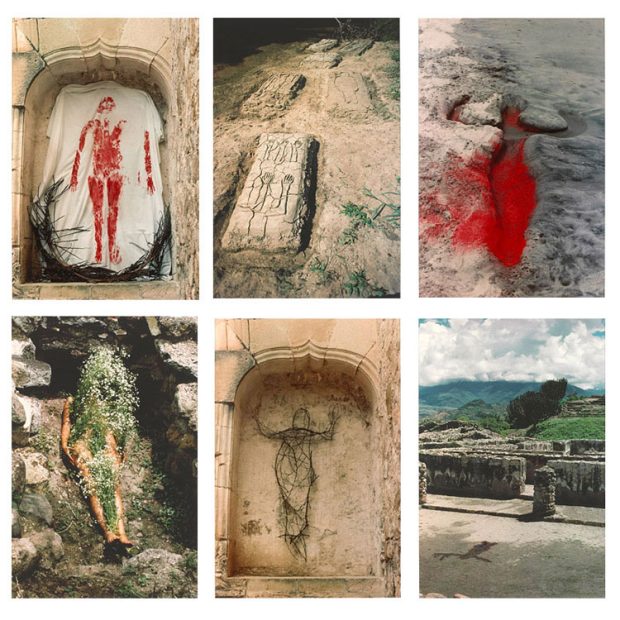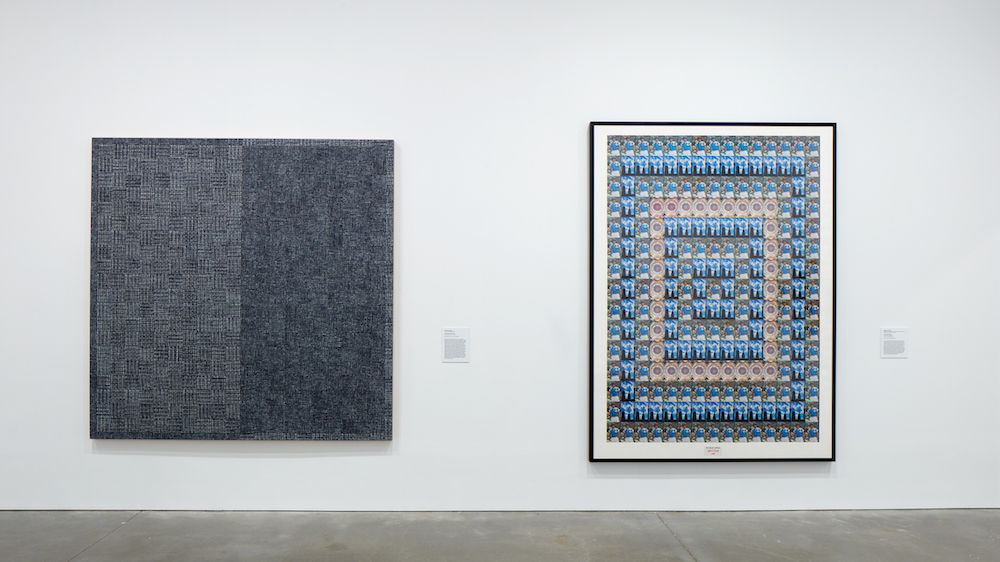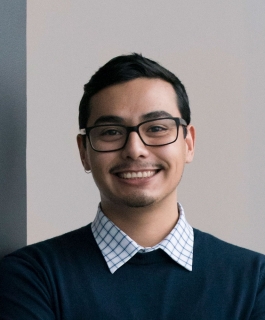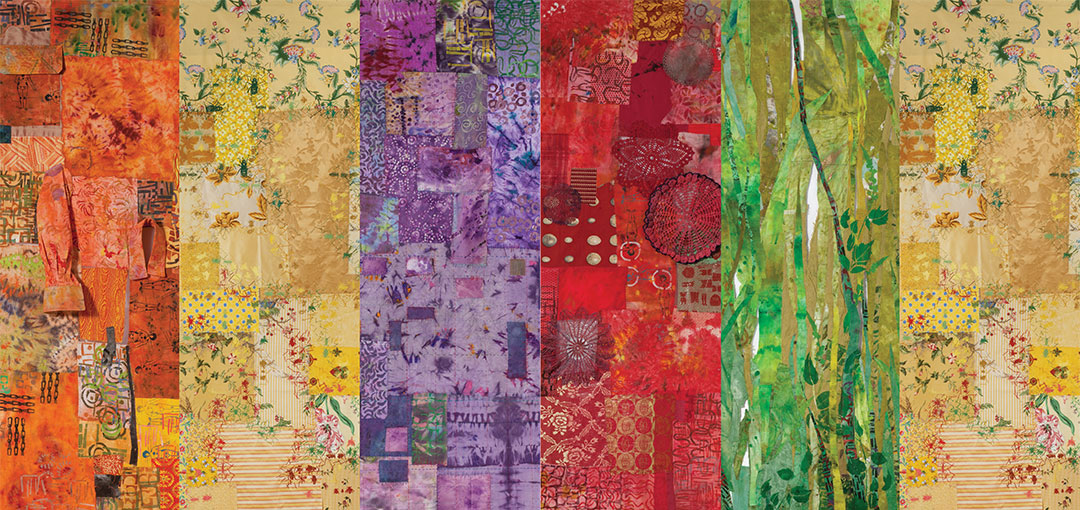(Boston, MA—February 4, 2020) The Institute of Contemporary Art/Boston (ICA) has invited local fiber artist Merill Comeau to create an interactive installation and project in the museum’s Bank of America Art Lab with the debut of Threads of Connection, opening February 15. Comeau creates artwork that combines and layers hundreds of hand painted and printed repurposed textiles. Through this labor of love, Comeau stitches together stories of cultures, individuals, and relationships into dynamic and sprawling fiber works.
Threads of Connection is a wall-sized tapestry installation that recognizes the building of community found within the age-old practice of gathering to assemble fabric pieces in quilting bees. This interactive project celebrates and reflects on the many different backgrounds and experiences of the people visiting the Bank of America Art Lab, as visitors of all ages are invited to collaborate in the making of the tapestry and share their stories in the museum’s own quilting bee. Contributions from visitors will be added to the tapestry regularly, creating a constantly growing reflection of the community.
Threads of Connection will be open on Saturdays and Sundays from 12–4 PM, from February 15 through June 21. The activity is free for all visitors with museum admission.
February School Vacation Week
Come visit us during school vacation week! Explore the galleries and create art together in the Bank of America Art Lab with art-making activities for visitors of all ages. Threads of Connection will be open 11 AM–4 PM during on Monday, Wednesday, Thursday, and Friday of February school vacation week. Admission on Presidents’ Day (Monday, February 17) will be free for all. Visit icaboston.org for more details and schedules as program dates approach.
Meet the artist on February 20, February 29, and April 23
Visitors are invited to meet Merill Comeau and learn about her creative process. More information at icaboston.org.
ICA Play Date: Crafting Community
Sat, Feb 29, 10 AM–4 PM
Kids rule the ICA the last Saturday of every month, when the museum fills up with fun, creative, and even zany activities for kids and adults to do together. Join Merill Comeau in the Bank of America Art Lab for a printmaking workshop and contribute to the growing community tapestry. We are excited to partner with Boston-based Wee the People, a social justice project for kids, as they explore themes from current exhibitions through storytelling and making. For ICA Play Dates, admission is free for up to 2 adults per family when accompanied by children ages 12 and under. Youth 17 and under are always admitted free to the ICA.
Also on view
Threads of Connection will be open during the ICA’s forthcoming exhibition Sterling Ruby, opening February 26. The exhibition is the first comprehensive museum survey for American/Dutch artist Sterling Ruby. The exhibition features more than 70 works that demonstrate the relationship between material transformation in Ruby’s practice and the rapid evolution of contemporary culture, institutions, and labor. Spanning more than two decades of the artist’s career, the exhibition features an array of works created in various mediums, from his renowned ceramics and paintings to lesser-known drawings and sculptures. Since his earliest works, Ruby has investigated the role of the artist as an outsider. Critiquing the structures of modernism and traditional institutions, Ruby addresses the repressed underpinnings of U.S. culture and the coding of power and violence, employing a range of imagery from the American flag to prison architecture and graffiti. Craft is central to his inquiry, informed by his upbringing in Pennsylvania Dutch country and working in Los Angeles, as he explores hand-based processes from Amish quilt-making to California’s radical ceramics tradition.
About the artist
Merill Comeau is a Boston-area mixed media artist specializing in textiles. She has participated in over 80 exhibitions including at the Fuller Craft Museum, Danforth Art Museum, Fitchburg Art Museum, Museums of Old York, MA and the Edward M. Kennedy Institute of Boston. Her installation Family of Origin is currently touring with FiberArt International 2019 and will travel to the Fort Collins Art Museum in Colorado in 2020. Comeau has completed ten artist residencies including three month-long stays at Weir Farm National Historic Site in CT where she researched Weir family women’s lives to use as art-making inspiration. She has been a guest artist in residence and exhibited at Southern New Hampshire University, Simmons College, Lasell University, Stonehill College, Dana Hall School and Phillips Exeter Academy. Comeau’s work has been showcased in numerous publications including Surface Design Journal, TextileArtist.org, Fiber Art Now, Textile Study Group of New York’s blog, Mass Cultural Council’s ArtsSake blog, and World of Threads Artist Interviews. In addition to her solo studio practice, Comeau facilitates the emergence of artistic voices. Since 2012, she has been a teaching artist for the Department of Youth Services making art with youth residing in secure treatment centers while serving sentences in the Massachusetts court system. In her trauma informed practice she uses visual expression as storytelling, transmitting knowledge, and defining values. She has executed over 30 public projects resulting in individual and collaborative artworks. In 2019 she taught at Eliot School of Applied Arts and Craft in Boston and the Surface Design Association’s biennial conference in St. Louis, MO. In addition to teaching, Comeau provides lectures on her work, fiber arts in a postmodern context, and visual voices of social justice.
About the ICA
Since its founding in 1936, the ICA has shared the pleasures of reflection, inspiration, imagination, and provocation that contemporary art offers with its audiences. A museum at the intersection of contemporary art and civic life, the ICA has advanced a bold vision for amplifying the artist’s voice and augmenting art’s role as educator, incubator, and convener for social engagement. Its innovative exhibitions, performances, and educational programs provide access to contemporary art, artists, and the creative process, inviting audiences of all ages and backgrounds to participate in the excitement of new art and ideas. Spanning two locations across Boston Harbor, the ICA offers year-round programming at its iconic building in Boston’s Seaport and seasonal programming (May-September) at the Watershed in an East Boston shipyard.
The ICA is located at 25 Harbor Shore Drive, Boston, MA, 02210. The Watershed is located at 256 Marginal Street, East Boston, MA 02128. For more information, call 617-478-3100 or visit our website at icaboston.org. Follow the ICA at Facebook, Twitter, and Instagram.
Play Dates are sponsored by Vivien and Alan Hassenfeld, the Hassenfeld Family Foundation, and Alexion.
Major support for Sterling Ruby is provided by Sprüth Magers, Gagosian, and Xavier Hufkens.

Additional support for the Boston presentation is generously provided by Stephanie Formica Connaughton and John Connaughton, Jean-François and Nathalie Ducrest, Bridgitt and Bruce Evans, James and Audrey Foster, Ted Pappendick and Erica Gervais Pappendick, David and Leslie Puth, and Charlotte and Herbert S. Wagner III.






